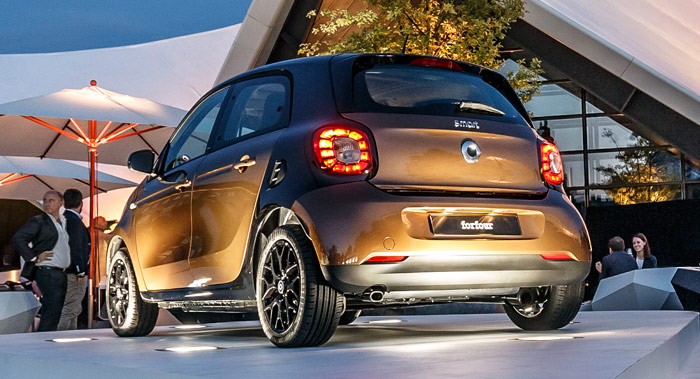For a long time, there has been something –ahem- dumb about Smart; even if one thought that their cars were right, the strategy was wrong. The company offered one basic vehicle in different trims, and let it languish on the market. Last week, the Daimler subsidiary unveiled two new models – the appropriately named Fortwo and Forfour. The debuts come not a moment too soon for the microcar brand, whose novelty has long subsided since its 1998 market introduction.
The new vehicles highlight a fresh design language previewed by Smart concepts over the past couple years. It now has an elongated hood, for what Smart calls a one-and-a-half-box design. The headlights and taillights are squircles, and feature LED signatures. In sum, the cars are a refreshing reimagining of Smart design. Bold two-tone paint contrasts, sporty wheel designs, and an invigorating, high-quality cabin bolster that belief.
In short, the cars are cool-looking little bastards. Finally, Smarts can compete on cuteness with Minis and Fiat 500s – even if they are smaller than those vehicles. That does not mean everyone is happy. Indeed, some commenters on this site were revolted by the designs. But Smart has always been a controversial brand. Polarity is an occupational hazard.
It’s not a stretch to say Smart can expect a global sales resurgence when these models hit showrooms. The crisp sheetmetal is reinforced with a smoother dual-clutch transmission, a more comfortable ride, and added safety features.
But what happens after all of the Smart loyalists upgrade to the new model? How does Daimler maintain momentum? The BMW Group, their archrival, may have some answers.
For one, Smart must go bigger. Literally. Mini learned long ago that young people interested in small European hatchbacks eventually have kids and need more car. Enthusiasts may laugh at the Countryman for not being “mini,” but the BMW Group is dead serious. The vehicle was a game changer. In one fell swoop, it widened Mini’s appeal and bolstered its sales.
 Therefore, Smart should use the ForMore nameplate on a CUV. The last ForMore was aborted before reaching production because of cost. The CUV can and should be the smallest vehicle in its class, but it should be increased in all dimensions over the Forfour, as well as offer ground clearance and all-wheel drive. And they shouldn’t forget triple-figure power. Please. It would instantly be Smart’s bestselling model.
Therefore, Smart should use the ForMore nameplate on a CUV. The last ForMore was aborted before reaching production because of cost. The CUV can and should be the smallest vehicle in its class, but it should be increased in all dimensions over the Forfour, as well as offer ground clearance and all-wheel drive. And they shouldn’t forget triple-figure power. Please. It would instantly be Smart’s bestselling model.
Second, Smart must go wider. It is imperative Daimler pursues vehicle proliferation. It is not enough to sell a Fortwo hatch, Fortwo convertible, and Forfour in different trims and with different powertrains. Smart showrooms need a lineup, not a car with different lengths and roof treatments. Smart should develop a Forfive mini-MPV that offers more space and less style than a Formore. A fashion-forward shooting brake should also be on offer. Finally, Smart should reintroduce its Coupe and Roadster to be design and performance flagships.
A broad Smart lineup is not only good for Smart customers. It is also good for Daimler. If done right, proliferation brings high volumes. Adding models to Smart’s lineup can help Daimler increase sales, and take pressure off from Mercedes-Benz to go downmarket.
Smart has already proven it can revolutionize the city car. Isn’t it time they continue evolving the concept? Shouldn’t they offer all manner of bodystyles with clever, sophisticated packaging to suit the city dweller’s needs?
Third, Smart must go farther. Mini makes it a point to import all vehicle bodystyles to the United States, the world’s second largest new car market. On the other hand, Daimler decided not to import the Forfour to the United States. The company suggested it would be a waste of money because Americans would not be interested.
What?!
A Forfour may well be the *only* Smart Americans are interested in. It has four doors, four seats, and unlike the Fortwo, it does not look like it can be purchased at Toys “R” Us. The four-seater would have the potential to change brand perceptions in the U.S. While the Forfour is still quite tiny, its extra doors and more traditional shape would hew more closely to American tastes, and may improve Smart’s safety perceptions on this side of the Atlantic.
If Daimler took these or similar steps, they would be seizing a tremendous opportunity. Everyone knows what a Smart is. Now the question is how to get people to buy one instead of laugh at one? In the process of answering that question, Daimler can finally prove that it can juggle more than one ball at a time. It can demonstrate that it is just as committed to Smart’s success as it is to that of Mercedes-Benz, even if that has never before been true.
By Nico Grant
















































